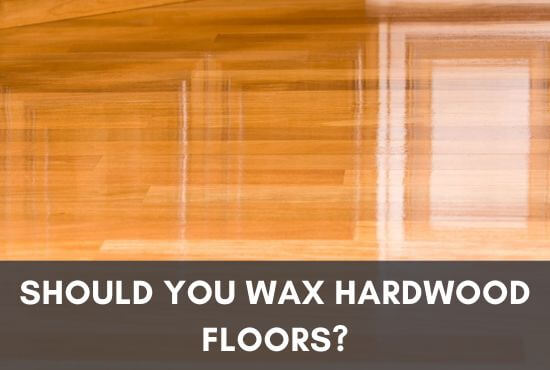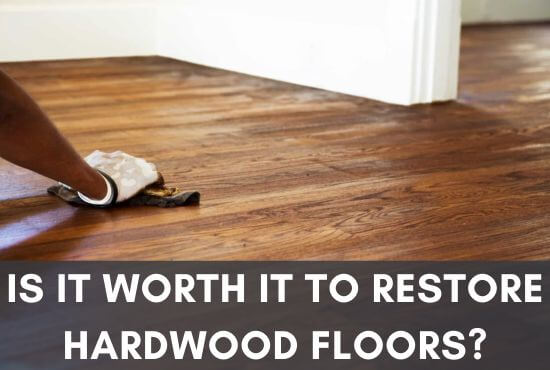Darkening hardwood floors is one of the oldest ways to change the color of the flooring and to hide signs of minimal damage.
Staining floors is a common practice and be it for a lighter or a darker shade, it usually involves sanding.
The reason being is that according to common understanding, the wood needs to be stained directly in order to achieve the look. But if you can’t sand your floors, how are you supposed to darken them through staining?
You can darken hardwood floors without sanding by using bonding methods like chemical bonding or screening and recoating. These methods allow staining and darkening without the need for sanding. Newer stains can be applied on varnishes and finishes, not just directly on the wood.

Due to this reason, staining wood without sanding has become a lot easier. However, there are many other factors in this situation which need to be addressed. Read all the information below to ensure you don’t miss out on anything important.
Table of Contents
- 1 How To Darken Hardwood Floors Without Sanding?
- 2 How To Decide Whether To Sand Your Hardwood Floors Or Go For A Darker Stain?
- 3 What Type Of Stains Are Preferred To Darken Hardwood Floors Without Sanding?
- 4 Can You Stain Over Hardwood Floors Without Sanding?
- 5 What Happens If I Stain Hardwood Floors Without Sanding?
- 6 Takeaway
How To Darken Hardwood Floors Without Sanding?
The best way to darken hardwood floors without resanding is to use chemical bonding agents or screening and recoating.
It doesn’t matter if you have traditional hardwood, prefinished, engineered, or laminate flooring.
Sanding hardwood floors is a common factor among all of them. Although it is very important at times, it might not always be necessary.
Besides, those people who have engineered or prefinished hardwood floors might need help sanding them.
Darkening hardwood floors often require the removal of the existing finish to apply the stain.
However, if you don’t want to or can’t sand the floors for any reason, there are still methods through which you can darken the hardwood floors.
Preparing The Room For Refinishing
- Clean your hardwood floors thoroughly.
- Ventilate the room properly.
- Wear eyeglasses and gloves.
- Polish the floors if needed.
- Use a pre-stain conditioner for wood.
- Follow the procedure you have chosen.

Below are two of the most common methods to darken hardwood floors without sanding them. Both work well and can suit you depending on your requirements and goals.
Screening & Recoating
If you can’t sand your floors, screening, and recoating can help you darken the color of your hardwood floors and allow you to stain over the varnish and seal.
While you might be thinking of it as an absurd idea, this adhesion technique involves mechanical buffing and abrading the floors.
Special machinery and other tools are used in the process, which involves light abrading of the floors. This is followed by a buffing session which causes many scratches on the hardwood varnish.
The best part about this process is that it only partially removes the existing finish of your hardwood floors.
Make sure you only use this method on finished floors; otherwise, you will end up with scratched hardwood floors with irreversible damage.

The light abrading causes micro scratches on the surface of the existing finish. Once this is done, you can apply the stain of your choice to darken the color of the wood.
The stain will improve the wood’s color and appearance and cover the scratches. However, you must not apply too much stain to fill the scratches as these are the medium for the new coat to immerse and bond with the older one.
Hence, the hardwood floors get a darker stain and achieve dual coat protection where the old and new coats are merged to make one stronger coat.
This method restores the shine and appearance of the hardwood floors without sanding. If you want to learn other ways to restore shine, I encourage you to read this article about perking up old hardwood floors.
Furthermore, it provides even stronger protection which is much more efficient and long-lasting as compared to sanding and restaining hardwood floors.
However, the only drawback of this is the unavailability of machinery in many areas.
As this process is new and not very versatile in different areas, the availability of such machinery in all areas has yet to be possible.
Therefore, if your area does not feature such facilities, you must choose another method of darkening your hardwood floors without sanding them.
Use Bonding Agents
Bonding agents are one of the most common and useful methods to darken and stain hardwood floors without having to sand them.
This process works similarly to the screening and coating method, but the only difference is that instead of machines, chemicals are used to allow the new varnish to bond with the previous one and seal the stain.
If you don’t want to remove the existing finish using an abrasion kit but still want to stain them to have a darker color and appearance, using chemical bonding agents is your best option in this scenario.
The process uses an adhesion promoter or bonding agent, allowing the new coat to bond with the existing one.

It follows the same basic principle as screening & recoating, but the only difference is that here chemicals are used instead of automated procedures, which makes the process much easier and cheaper.
You can apply the stain on your existing floors after cleaning them. Applying the stain before or after the bonding agents is entirely your choice, depending on the look you want to achieve with your hardwood floors.
Once the bonding agent has worked its charm, the new coat will stick to the old one just as a double-sided tape and provide additional protection to the hardwood floors. This process is highly suitable if the hardwood floors have a partially worn-out finish.
You don’t need to perform sanding or abrasion on the varnish in this case, as there is still a substance that will protect your floors.
Hence, adding another coat is the most practical idea to ensure that the floors are given optimum protection.
This helps to darken the color of your hardwood floors without removing the existing varnish, which will still give you a few more months.
Besides, add that to another layer, and you have increased overall longevity on your floors; hence, you will benefit from this procedure.
Moreover, the process also seals the stain under the new layer, allowing for additional protection. Therefore, your wood’s darker appearance will stay protected and will not fade away due to wear and tear factors.
How To Decide Whether To Sand Your Hardwood Floors Or Go For A Darker Stain?
The best way to decide whether you need to sand or stain hardwood floors is to check the wood’s type and condition and then come to a conclusion.
The question is not so simple as to have a straightforward answer. Hence, you would have to ponder upon a few factors to understand how the procedure works and how you can choose what is best for your hardwood floors.
Sanding and staining achieve different goals, and depending upon your preference and the state of your hardwood floors, you might need or want one for your flooring.

While sanding grinds down the wood surface to make the texture smoother, the stain gives the right color to your hardwood floors and allows you to customize the floors according to your liking.
In addition, stains also provide the necessary moisture to the wood to prevent it from looking dry and rough and keep it shining while maintaining the wet appearance (if given).
Type of Floors
The first factor you need to pay attention to is the type of floors you have. Different types of wood require different types of treatments; hence, you can’t apply the same procedures to all of them.
Although you can get the exact information from the manufacturer or the dealer from which you bought your floorings, here is a general idea of what wood types are to be sanded or stained.
In cases where unique hardwood is installed in the house, such as mahogany, maple hardwood, cherry, and walnut, such woods should not be stained. These exotic types of wood are not to be stained due to their original appearance.
These types of woods are usually high-priced, so they look beautiful in their natural state and tempering with the that is not recommended.
Moreover, the real purpose of staining wood is to imitate the appearance of these wood types.
As these are quite expensive to get by and not everyone can afford them, people tend to stain their hardwood floors with colors of these woods to get a similar appearance.
In addition, most of these wood types are oily in nature or have a very tight wood grain. This disallows the stain to get absorbed and prevents proper curing.
Hence, this results in the stain not drying or getting absorbed, creating a sticky paint-like appearance on the surface.
Therefore, it is not suitable to even attempt to stain these floors as, most probably, you will end up spoiling their natural look, and the results would be nowhere near desirable.
It is preferred that you leave them be and do not attempt to stain or darken them.
Such wood types should be sanded when necessary and sealed to protect them from any unwanted accidents. Occasionally, polishing these wood types is possible, but that should not be overdone.
Moreover, if you have naturally dark wood types, you should refrain from attempting to stain them. An example would be the Ipe or Jatoba, which are premium-class woods with a naturally dark tone.
The reason behind this is that staining a wood type that is already dark is pointless. Light colors can be stained darker and differently shaded but attempting to stain a darker color even darker or lighter is not a sensible idea as the colors can’t match or blend this way.
In addition, these wood types also have a high oil content, making it near impossible for the wood stain to be absorbed.
You will only be left with a sticky and slippery surface on your hardwood floors which won’t dry, and eventually, you will have to wash the floors or get them removed professionally.
Hence, it is best not to attempt any such thing. On the other hand, if you have more common hardwood floorings installed in your house, you can stain them without any worries.
For instance, white or red oak is one of the best receivers of stain as they absorb the stain very well and give you the desired look almost immediately.
The natural appearance of these woods could be better, which is why they are placed in a mid-range price segment and are affordable for many people.
Moreover, some types of varnishes can turn these wood types to a yellowish-orange hue which is not desirable by many homeowners.
It gives the wood an aged and rough appearance and makes them lose its shine and original appearance. A common example is oak sealed with oil-based finishes; in this case, staining offers the best solution to this problem.
It can prevent discoloration and allow you to change the look and appearance of your hardwood floors whenever you attempt to refinish them.
In addition, if you opt for the newer water-based finishes, you will find little luck as they can give a washed-out look to unstained floors and make them appear dull and lifeless.
Hence, staining is a suitable option to bring your hardwood floors to life and increase their appeal by a significant factor.
Oak floors are the best candidates to receive staining; however, other floors in this segment respond well to staining too.
It will help if you contact the manufacturer or the store owner to get guidelines precisely about your hardwood flooring type to decide whether you need to sand or stain your hardwood floors.
Extent of Damage
The extent of damage your hardwood floors receive is one of the most determining factors when deciding whether to stain or sand your hardwood floors.
If you are not aware of this fact, staining is not only helpful in improving the color of your hardwood floors but also helps to hide scratches and small dents by filling them up and giving the floor a leveled and seamless appearance.
Therefore, staining is the best solution in scenarios where the damage is too little for sanding but still obvious enough to mar the overall look of your floors.
For instance, if you had a pot plant on your hardwood floors that kept leaking and damaging the surface of your floors, or you have a pet in the house with big nails that scratch the floors too often, you can stain the floors in a darker tone to hide the damage.
While sanding the floors might not be as suitable in this situation, and replacing the boards can be too costly, staining can rejuvenate the floor’s appearance without the added expense of repairs or replacements.
Water damage, scratches, scuff marks, and minor dents are surface damages. These can be muted by staining your hardwood floors with a darker color.
However, if the source of the damage is not controlled on time, you might have to move towards repairing techniques, including sanding the floors.
What Type Of Stains Are Preferred To Darken Hardwood Floors Without Sanding?
Different stains, such as Dark Walnut, Provincial, and Jacobean, are used for darkening hardwood floors.
These wood stains are the most popular ones among all of them and offer a wide variety of customizations and unbelievable versatility.
Regardless of the color or texture of your wood, these stains can work with various color palettes and suit environments with both traditional and contemporary settings depending upon how you use them.
Another added feature is the absence of red undertones in these stains, perhaps the greatest reason behind their versatility.
Besides, they are fairly easy to use as you can apply them straight out of the packaging or even mix different colors to achieve new shades to match best and complement the environment you are using them in.

If you know how to mix them right, you can achieve many desired looks with these stains, such as coffee, a good, medium brown shade, or even espresso.
However, if you are newer to this theory, you might need to know which shades to mix to get what results.
A useful tip is blending Dark Walnut, Provincial, or Jacobean shades with Natural. This will help you lighten the color as much as you want and will not disturb the tone of the hardwood floors.
Despite your preference, you can get any base color in stains and stain your hardwood floors in any color, such as green, blue, or bright red.
However, if you don’t find the desired color of the stain or the manufacturer does not offer it, you can still blend different colors and get the exact tone and shade desired for your hardwood floors.
The process is relatively easy and requires only a few steps. Firstly, you must identify the shade and color you want on your hardwood floors.
Once that is done, you need to find the color and shade closest to the one you decide on, if not the exact one.
Next, you need to start experimenting with tones and colors by mixing them with different colors to find out where you are getting and whether you can achieve the right color shade.
Searching for the right combination for your desired shade is preferred to save yourself a lot of time and effort.
In addition, it is important to note that you must mix the colors in equal quantities to get accurate results.
Moreover, ensure you are only mixing small quantities and not the entire product so you don’t waste the products or get undesirable results.
Once you have found the right color and shade for your floors, try it out on a small area of the floor to test the results.
Let the stain dry and see if you like it; if the color and shade are according to your taste, you need to make more of it using the same proportions you followed for the small testing sample.
Once ready, you can apply the stain on your floors and enjoy the new colors. If you think doing so is too much of a hassle, you can hire a professional for this job.
The professional will test out different shades for you, and with their experience, they can try accurate combinations and quickly come up with the exact tone you are looking for.
Can You Stain Over Hardwood Floors Without Sanding?
Staining hardwood floors without sanding through screening and recoating and using chemical bonding agents is possible.
These methods work very well if you don’t want to waste your existing varnish and want to retain it, as they allow you an added coat of protection
However, if you want to remove the existing finish, you can opt for chemical abrasion. A chemical abrasion kit is available in the market and corrodes the finish layer allowing you to scrub it off.
Moreover, you can also use liquid or gel-based strippers, which are specially designed to allow you to remove the varnish without sanding.
If you are someone who does not believe in exposing chemicals to hardwood surfaces but still want to remove the varnish, you can use a heat gun to soften the layer and then use a metal scraper to scrape it off.
Once these steps are done, you can easily stain your hardwood floors without sanding using the earlier procedures.
What Happens If I Stain Hardwood Floors Without Sanding?
Staining your hardwood floors without sanding does not have any adverse effects. If your floors have received slight damage, such as getting scratched, scuffed, or dented, you can easily mute such damages through staining without having to sand, refinish or resurface the floors.
However, if your hardwood floors have received extensive damage and need repairs, there are better options than staining them over sanding.
If a sanding session is required due to their condition and refinishing has become inevitable, ignoring this step will only bring chaos to your floors.

The hardwood floors can suffer from serious damage in this situation and might get weak and hollow over time, making repairs or replacements inevitable.
Hence, it is crucial to identify the state of your hardwood floors through the guide above so you don’t make a worn decision and risk the health and integrity of your hardwood floors.
Takeaway
Hardwood floors can be darkened without sanding and if your flooring professional tells you otherwise, it is better to not pay heed to their opinion.
However, it is important to identify first that you are not giving preference to staining over sanding in a situation where sanding is crucial.
As you don’t want to risk the health and condition of your hardwood floors, please make sure this is not the case.
Once this is done, you can decide whether you want to keep the varnish or not, and if not, we have already provided you with methods to remove the finish without sanding it.
Hence, you can easily proceed towards staining your hardwood floors and giving them the darker shade you like.
So don’t just sit there and procrastinate on this subject, make notes from the discussion above and give your hardwood floors a facelift today!

As a co-creator of FlooringFlow.com, Emma Sophia comes on board to answer all your questions related to any flooring problems. Together with John Henry, she’s gained extensive experience in fixing many flooring problems in their own house as well as in friends and family’s. Now, she wants to share her knowledge that she gained during floor remodeling, restoring, and DIY projects.




![70 Bedroom Color Schemes: [year] Home Bedroom Refresh 70 Bedroom Color Schemes: [year] Home Bedroom Refresh](https://flooringflow.com/wp-content/uploads/2024/07/25-Cool-4th-of-July-Decorations-for-Outdoor-Patio-to-Celebrate-in-Style-16.jpg)


